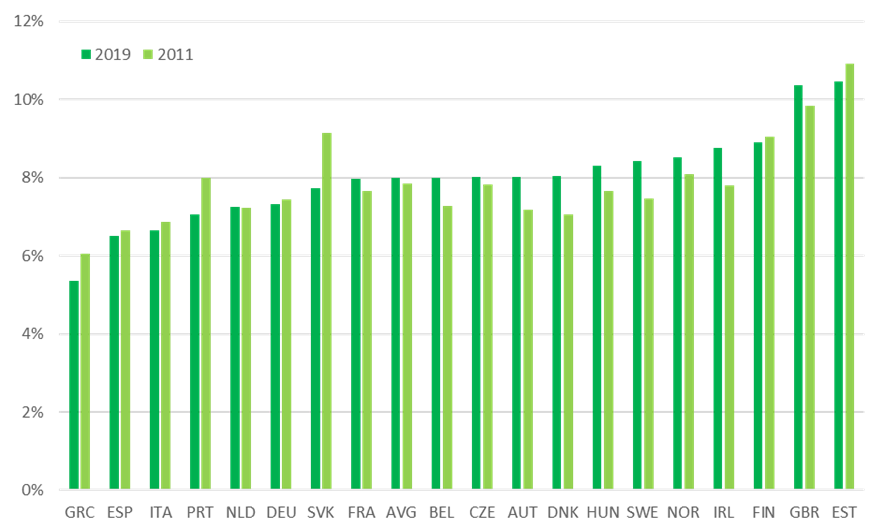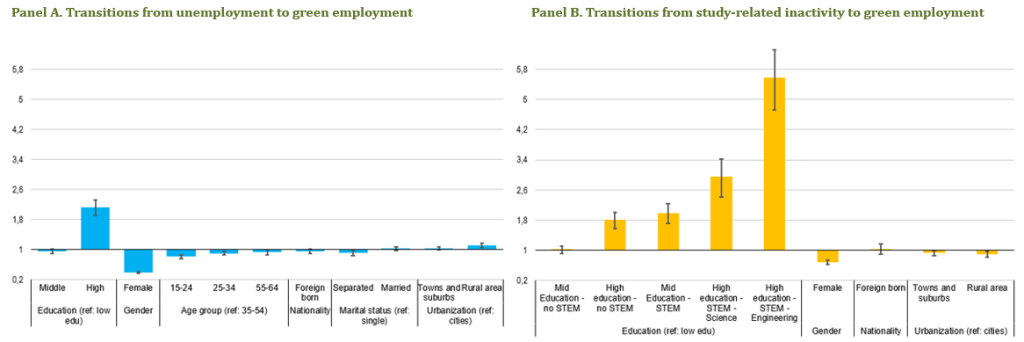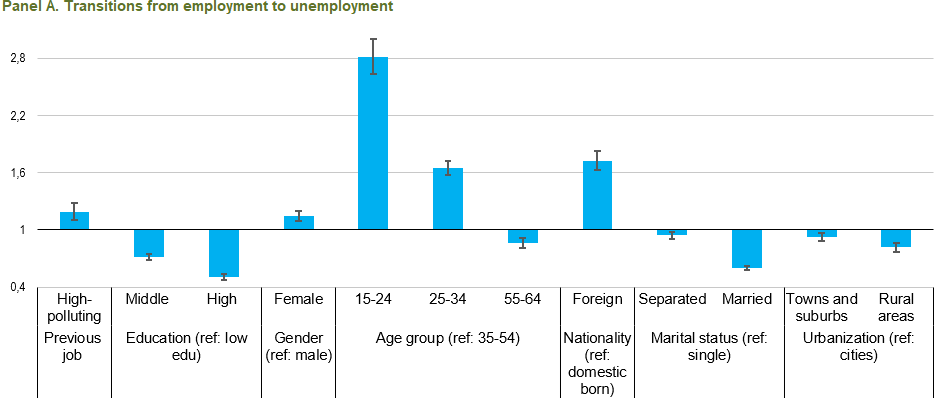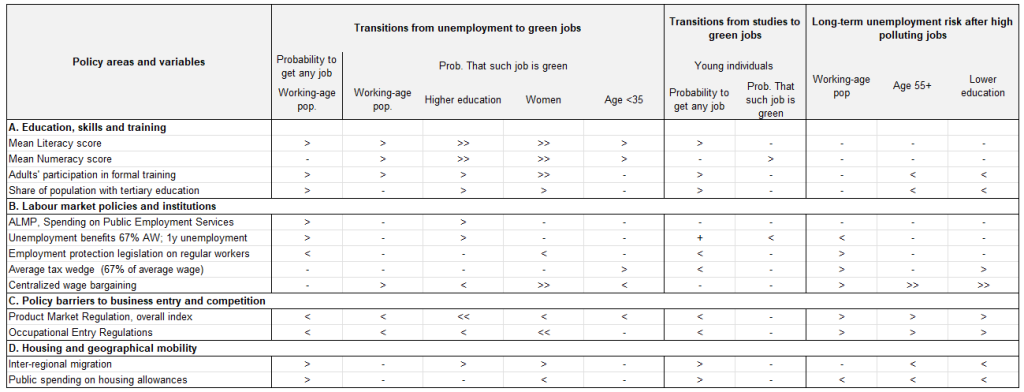

This article is based on OECD Economics Department Working Papers No. 1803 “Labour markets transitions in the greening economy: structural drivers and the role of policies”.
Abstract
The transition to a greener economy may create opportunities of employment growth in so so-called green jobs, which have higher incidence among high high-educated workers, and challenges for those in high high-polluting occupations, most common among individuals with lower lower-education or living in rural areas. Econometric analysis of the individual individual-level drivers of transitions from non-employment to employment in over 20 EU countries reveals that higher education, especially in scientific and technical subjects, increase the odds of getting a green job both for unemployed workers as well as for younger individuals entering the labour market. To promote transitions from joblessness to employment in green jobs, education and training policies are fundamental, along with active labour market policies, cash support to unemployed workers, and well well-designed collective bargaining institutional settings. Such transitions are instead hindered by excessively stringent regulations on employment protection, and business and labour market dynamism.
The transition to a greener economy requires a combination of policies and technological change which are likely to result in a considerable reallocation of production factors, including workers. Although the overall effects in terms of aggregate economic output and employment are predicted to be relatively small (Chateau, Bibas and Lanzi, 2018[1]; Borgonovi et al., 2023[2]), the effects are likely to be concentrated: by economic activity, geographical aera and workers’ characteristics (Pisani Pisani-Ferry, 2021[3]; Känzig, 2023[4]; Vandyck et al., 2021[5]; Demetriades, Cabrita and Fóti, 2021[6]), with a risk of amplifying inequalities in outcomes and opportunities. In particular, the transition is expected to induce a contraction of jobs in high high-polluting activities, often labelled as brown jobs in the literature, and an expansion of the so called green jobs, i.e ., those jobs which are instrumental to achieving greener production processes because, irrespective of their direct or indirect effects on the environment, they require the capacity to perform green tasks (Valero et al., 2021[7]; Consoli et al., 2016[8]; Vona, Marin and Consoli, 2018[9]; Vandeplas et al., 2022[10]).
In recent OECD work (Causa, Nguyen and Soldani, 2024[11]) we develop a new harmonized classification of green and high polluting jobs across EU countries, allowing a consistent cross cross-country empirical analysis of the labour market effects of the green transition, covering the pre-COVID 19 decade. In follow follow-up work (Causa et al., 2024[12]) we analyse labour market transition from non-employment to employment in green jobs (as defined above), and from employment in high high-polluting activities to unemployment, with a focus on distributional aspects by looking at workers from different socio socio-economic groups by e.g. age, gender, education level. We then shed light on the role of structural policies in shaping these transitions; based on OECD policy indicators in a wide range of areas including labour market policies and institutions, social protection, wage bargaining settings, education and training, as well as barriers to product markets and to business and labour market dynamism.
The results show that the green transition has so far been moderate across European labour markets: labour force surveys data from 21 EU member countries reveals minor shifts in the shares of green and high polluting jobs (as defined above) in the decade leading up to the Covid 19 pandemic (Figure 1).
Figure 1. Panel A – Employment shares of occupations characterized by green skills, 2011 and 2019

Figure 1. Panel B – Employment shares of high-polluting occupations, 2011 and 2019

Source: Causa, Soldani and Nguyen (2024[13]). See paper for details on the definitions and data.
Going more granular than the aggregate picture, we find that the incidence of green and high high-polluting jobs varies significantly across countries and regions and presents common patterns across workers characteristics like gender, educational attainment and area of residence (Causa, Soldani and Nguyen, 2024[13]; OECD, 2023[14]). Men are more likely to hold both green and high polluting jobs relative to women, while women are more likely to hold environmentally neutral jobs, typically in contact contact-intensive services like education and health, even when holding fixed other characteristics such as educational attainment. Additionally, green jobs are more frequent among workers with higher educational attainment, and high high-polluting jobs among those with lower educational attainment and those living in rural areas (Figure 2).
Figure 2. Panel A – Employment shares of occupations characterized by green skills, selected groups

Figure 2. Panel B – Employment shares of high-polluting occupations, selected groups

Source: Causa, Soldani and Nguyen (2024[13]). See paper for details on the definitions and data.
The role of educational attainment is also confirmed by econometric analysis of the individual individual-level drivers of transitions from non-employment to green jobs. Ceteris paribus, the odds of getting a green job are twice as high for workers with high levels of education relative to workers with low levels of education (Figure 3, Panel A). Among young individuals, the odds of transitioning from studying into working in a green job are about three times higher for those with a degree in science technology or mathematics, and six times higher for those who obtained a degree in engineering, with respect to those with low educational attainment (Figure 3, Panel B). These findings underline the need to foster access to quality education, training, and skills, in particular to remove barriers, including stereotypes and lack of access to STEM fields of study for target groups such as young women (OECD, 2017[15]; OECD, 2023[16]; OECD, 2023[17]).
Figure 3. Transitions from non-employment to green employment: key results
Estimated odds ratios & confidence intervals from logistic regressions

Note: Baseline results report odds ratios and confidence intervals associated with individual characteristics based on estimated transitions models from employment to unemployment (Panel A) and long-term unemployment risks among unemployed individuals with past work experience (Panel B). This is obtained from logistic regressions run on a panel of European OECD countries over the period 2011-2019. The sample includes working age individuals. As explained in the text, the regressions include cyclical controls at the country and region level, as well as country, year, region and industry fixed effects. Odds ratios greater than 1 indicate that the variable is associated with greater odds of the transition happening; odds ratios of 1 reflect similar odds of the transition materializing; odds ratios below 1 suggest that the variable is associated with lower odds of the transition happening. The Annex report complete regression tables. How to read: The odds of unemployed individuals whose previous job was brown to become long-term unemployed are 0.86 relative to those of unemployed individuals whose previous job was non-brown, or 14% lower. Source: OECD estimations and calculations based on EU-LFS data.
Individual characteristics also play an important role in predicting the risk of job loss: while this risk is slightly higher among workers in high-polluting jobs, being young, of foreign origin and low educational attainment are most significant risk factors (Figure 4).
Figure 4. Transitions from employment to unemployment & displacement effects from brown jobs

Note: Baseline results report odds ratios and confidence intervals associated with individual characteristics based on estimated transitions models from employment to unemployment (Panel A) and long-term unemployment risks among unemployed individuals with past work experience (Panel B). This is obtained from logistic regressions run on a panel of European OECD countries over the period 2011-2019. The sample includes working age individuals. As explained in the text, the regressions include cyclical controls at the country and region level, as well as country, year, region and industry fixed effects. Odds ratios greater than 1 indicate that the variable is associated with greater odds of the transition happening; odds ratios of 1 reflect similar odds of the transition materializing; odds ratios below 1 suggest that the variable is associated with lower odds of the transition happening. The Annex report complete regression tables. How to read: The odds of unemployed individuals whose previous job was brown to become long-term unemployed are 0.86 relative to those of unemployed individuals whose previous job was non-brown, or 14% lower.
Source: OECD estimations and calculations based on EU-LFS data.
In this context, supporting workers’ transitions from non-employment to employment is a policy priority, not only to mitigate scarring risks for workers displaced from a high-polluting job, but also to encourage transitions towards those green jobs that are needed to reach environmental objectives (OECD, 2023[18]), and to contain inequality levels while seizing opportunities to revive historically low levels of productivity growth (Andre and Gal, 2024, forthcoming[19]; Soldani et al., 2024[20]). Econometric analysis suggests that in terms of promoting transitions from joblessness to employment in green jobs, the most promising policies are those related to education and training, active labour market policies, cash support to unemployed workers, and well-designed collective bargaining institutional settings, promoting effective social dialogue. Such transitions are instead hindered by excessive employment protection and excessively stringent regulations hindering business and labour market dynamism, such as product markets and occupational entry regulations.
More specifically, after accounting for individual characteristics and macroeconomic conditions, the transitions from unemployment to green-skill jobs are more likely in countries with higher adults’ proficiency in literacy and numeracy and with higher share of workers with formal training (Table 1, Panel A). For green-skill jobs, these positive associations are even stronger than the ones documented for generic employment, documented in previous studies (OECD, 2023[17]; Causa, Luu and Abendschein, 2021[21]). In addition, higher shares of population with tertiary education and higher adults’ participation in training are also associated with lower risks of long-term unemployment for individuals displaced from high-polluting jobs, especially among vulnerable groups such as younger and older workers, women, and those with lower educational attainment.
Labour market policies have been found to help workers cope with cyclical and structural changes and increase the probability to move from joblessness to employment (Boeri and Burda, 1996[22]; Card, Kluve and Weber, 2015[23]; Causa, Abendschein and Cavalleri, 2021[24]). In the context of the green transition, we find that spending on training, public employment services (PES), and employment incentives is associated with higher chances to transition from non-employment to green employment, yet only for higher-educated workers (Table 1, Panel B), suggesting the need to better design and target such policies for more exposed and vulnerable workers such as those with lower education.
To facilitate the matching of workers to new jobs, training and active labour market programs should be complemented with balanced and adequate income support and unemployment benefits, which are found to be associated with a higher probability to transition from unemployment to employment, particularly among long-term unemployed (Table 1, Panel B). Additional stimulus to transitions into green jobs may come from centralised wage bargaining, which is found to be associated with higher transitions from joblessness into green jobs, in particular for women, low-educated workers and those living in rural areas.
Consistently with the literature on the effects of employment protection legislation on labour market transitions (Bassanini and Garnero, 2013[24]; Causa et al., 2022[25]; Scarpetta, 2014[26]), too stringent job protection on regular contracts is associated with lower job-finding rates, including green jobs, especially for vulnerable groups, like younger individuals entering the labour force after completing their studies and for lower-educated unemployed workers. An effective and fair transition to a greener economy requires not only the entry of more workers into green jobs, but also the support to the workers who may lose their jobs in high-polluting jobs. Also in these terms, excessive product market regulations and barriers to entry in occupations can be detrimental (Boal and Ransom, 1997[27]; Lopez-Garcia, 2009[28]; Adalet McGowan and Andrews, 2017[29]) In the context of the green transition, in particular, we find that more restrictive product market and occupational entry regulations are associated with lower odds of transitioning from unemployment to green jobs, especially for vulnerable groups. Indeed, the negative effect of highly restrictive product market regulations on hirings is particularly strong for youth moving from study to work, and the one of high occupational entry regulations more detrimental to unemployed individuals with lower levels of education and those at risk of long-term unemployment (Table 1, Panel C). Taken together, these results warn against the risk that excessive job protection on regular contracts might hinder the transition to greener labour markets, while also reducing re-employment opportunities for vulnerable workers and new entrants.
Housing policies that favour residential mobility generally facilitate the spatial reallocation of workers and promote business dynamism, enhancing the ability of workers to seize job opportunities (Causa, Abendschein and Cavalleri, 2021[24]; Causa and Pichelmann, 2020[28]; Andrews, Caldera Sanchez and Johansson, 2011[29]). This is also the case in the context of the green transition: hirings from studies are hindered by strong house price dynamics, with higher house prices possibly hampering hirings of jobless individuals by creating barriers to mobility. Social rental housing and the provision of housing allowances (i.e., housing-related monetary benefits) both increase the odds for an individual to move from jobless to job, including green jobs, with the benefits of housing allowances being more widespread than those of social housing. At the same time, these housing support policies are associated with significantly lower risks of long-term unemployment, especially for low-educated individuals. Finally, reducing excessively rigid rental market regulations could also lift barriers to mobility and enhance transitions from jobless to job (Table 1, Panel D).
Table 1. Policies to support labour market transitions in the greening economy

Note: In the table, the expression “green jobs” indicates jobs in occupations characterized by green skills. The symbol “>” indicates a positive association (for example: an increase in the mean literacy score is associated with an increase in the probability to get a job in a green-skill occupation), “<” a negative association (for example, stronger employment protection on regular contracts is associated with lower probabilities of getting any job), and “-” indicates the absence of a statistically significant association between the policy and the outcome. When considering sub-populations, such as younger or older workers or women, the sign “>>” (“<<”) indicates that the association is positive (negative) and significantly more so than the association found for the general population. All associations are computed ceteris paribus, i.e., holding fixed the observable characteristics of workers, the year of the survey, the country and the corresponding macro-economic conditions, and, when relevant, the industry of occupation.
The impact of the transition to a greener economy and climate mitigation policies is likely to be small on aggregate, but uneven across people and places. A new harmonized classification of green and high polluting jobs across EU countries allows the analysis of labour market transitions from joblessness to employment in green jobs and from employment in high polluting jobs into unemployment. Considering distributional aspects such as heterogeneities across various socioeconomic groups, the empirical results point to a clear role for policies to help workers navigate the green transition. The transition can be supported by general structural policies favouring labour market efficiency in terms of workers’ reallocation, and labour market inclusiveness in terms of promoting equality of opportunities and minimising long long-term scars. These should be combined with specific and targeted interventions – including place place-based ones for regions at risk of economic and social decline – to promote green jobs and to reduce displacement costs from high high-polluting jobs and to ensure that workers and their communities are well well-equipped to face the potential adverse labour market effects of the green transition and move on to new economic opportunities.
Adalet McGowan, M. and D. Andrews (2017), “Skills mismatch, productivity and policies: Evidence from the second wave of PIAAC”, OECD Economics Department Working Papers, No. 1403, OECD Publishing, Paris, https://doi.org/10.1787/65dab7c6-en. [29]
Andre, C. and P. Gal (2024, forthcoming), Reviving productivity growth: A review of policies.. [18]
Andrews, D., A. Caldera Sánchez and Å. Johansson (2011), “Housing Markets and Structural [31]
Policies in OECD Countries”, OECD Economics Department Working Papers, No. 836, OECD Publishing, Paris, https://doi.org/10.1787/5kgk8t2k9vf3-en.
Bassanini, A. and A. Garnero (2013), “Dismissal protection and worker flows in OECD countries: Evidence from cross-country/cross-industry data”, Labour Economics, Vol. 21, pp. 25-41, https://doi.org/10.1016/j.labeco.2012.12.003. [24]
Boal, W. and M. Ransom (1997), “Monopsony in the Labor Market”, Journal of Economic Literature, Vol. 35/1, https://doi.org/10.3368/jhr.monopsony.special-issue-2022-introduction. [27]
Boeri, T. and M. Burda (1996), “Active labor market policies, job matching and the Czech miracle”, European Economic Review, Vol. 40/3-5, https://doi.org/10.1016/0014-2921(95)00091-7. [21]
Borgonovi, F. et al. (2023), “The effects of the EU Fit for 55 package on labour markets and the demand for skills”, OECD Social, Employment and Migration Working Papers, No. 297, OECD Publishing, Paris, https://doi.org/10.1787/6c16baac-en. [2]
Bowen, A., K. Kuralbayeva and E. Tipoe (2018), “Characterising green employment: The impacts of ‘greening’ on workforce composition”, Energy Economics, Vol. 72, pp. 263-275, https://doi.org/10.1016/j.eneco.2018.03.015. [32]
Card, D., J. Kluve and A. Weber (2015), What Works? A Meta Analysis of Recent Active Labor Market Program Evaluations, National Bureau of Economic Research, Cambridge, MA, https://doi.org/10.3386/w21431. [22]
Causa, O., M. Abendschein and M. Cavalleri (2021), “The laws of attraction: Economic drivers of inter-regional migration, housing costs and the role of policies”, OECD Economics Department Working Papers, No. 1679, OECD Publishing, Paris, https://doi.org/10.1787/da8e368a-en. [23]
Causa, O. et al. (2022), “Getting on the job ladder: The policy drivers of hiring transitions”, OECD Economics Department Working Papers, No. 1710, OECD Publishing, Paris, https://doi.org/10.1787/0304c673-en. [25]
Causa, O., N. Luu and M. Abendschein (2021), “Labour Market Transitions across the OECD: Stylised Facts”, OECD Economics Department Working Paper No. 1692. [20]
Causa, O., M. Nguyen and E. Soldani (2024), A new measurement approach for indentifying high-polluting jobs across European countries. [11]
Causa, O. and J. Pichelmann (2020), “Should I stay or should I go? Housing and residential mobility across OECD countries”, OECD Economics Department Working Papers, No. 1626, OECD Publishing, Paris, https://doi.org/10.1787/d91329c2-en. [30]
Causa, O., E. Soldani and Nguyen (2024), Lost in the green transition? Measurement and stylized facts. [12]
Chateau, J., R. Bibas and E. Lanzi (2018), “Impacts of Green Growth Policies on Labour Markets and Wage Income Distribution: A General Equilibrium Application to Climate and Energy Policies”, OECD Environment Working Papers, No. 137, OECD Publishing, Paris, https://doi.org/10.1787/ea3696f4-en. [1]
Consoli, D. et al. (2016), “Do green jobs differ from non-green jobs in terms of skills and human capital?”, Research Policy, Vol. 45/5, pp. 1046-1060,https://doi.org/10.1016/j.respol.2016.02.007. [8]
Demetriades, S., J. Cabrita and K. Fóti (2021), Distributional impacts of climate policies in Europe, Eurofond. [6]
Känzig, D. (2023), “The Unequal Economic Consequences of Carbon Pricing”, SSRN Electronic Journal, https://doi.org/10.2139/ssrn.4440716. [4]
Lopez-Garcia, P. (2009), “Business Environment and Labor Market Outcomes in European and Central Asian Countries”, The Journal of Entrepreneurial Finance, Vol. 12/4, https://doi.org/10.57229/2373-1761.1243. [28]
OECD (2023), Economic Policy Reforms 2023: Going for Growth, https://doi.org/10.1787/9953de23-en. [17]
OECD (2023), Education at a Glance 2023: OECD Indicators, OECD Publishing, Paris, https://doi.org/10.1787/e13bef63-en. [16]
OECD (2023), Job Creation and Local Economic Development 2023: Bridging the Great Green Divide, OECD Publishing, Paris, https://doi.org/10.1787/21db61c1-en. [13]
OECD (2023), Joining Forces for Gender Equality: What is Holding us Back?, OECD Publishing, Paris, https://doi.org/10.1787/67d48024-en. [15]
OECD (2017), The Pursuit of Gender Equality: An Uphill Battle, OECD Publishing, Paris, https://doi.org/10.1787/9789264281318-en. [14]
Pisani-Ferry, J. (2021), “Climate policy is macroeconomic policy, and the implications will be significant”, Policy Briefs, No. 21-20, Peterson Institute for International Economics. [3]
Scarpetta, S. (2014), “Employment protection”, The IZA World of Labor, https://doi.org/10.15185/izawol.12. [26]
Soldani, E. et al. (2024), Policy approaches to reduce inequalities while boosting productivity growth, OECD Publishing. [19]
Valero, A. et al. (2021), Are ‘green’ jobs good jobs? How lessons from the experience to-date can inform labour market transitions of the future, Grantham Research Institute, London school of Economics. [7]
Vandeplas, A. et al. (2022), The possible implications of the green transition for the EU labour market, EUROPEAN COMMISSION, https://commission.europa.eu/publications/economic-and-financial-affairs-publications_en. [10]
Vandyck, T. et al. (2021), “Climate policy design, competitiveness and income distribution: A macro-micro assessment for 11 EU countries”, Energy Economics, Vol. 103, p. 105538, https://doi.org/10.1016/j.eneco.2021.105538. [5]
Vona, F., G. Marin and D. Consoli (2018), “Green employment: What, where and how much?”,.